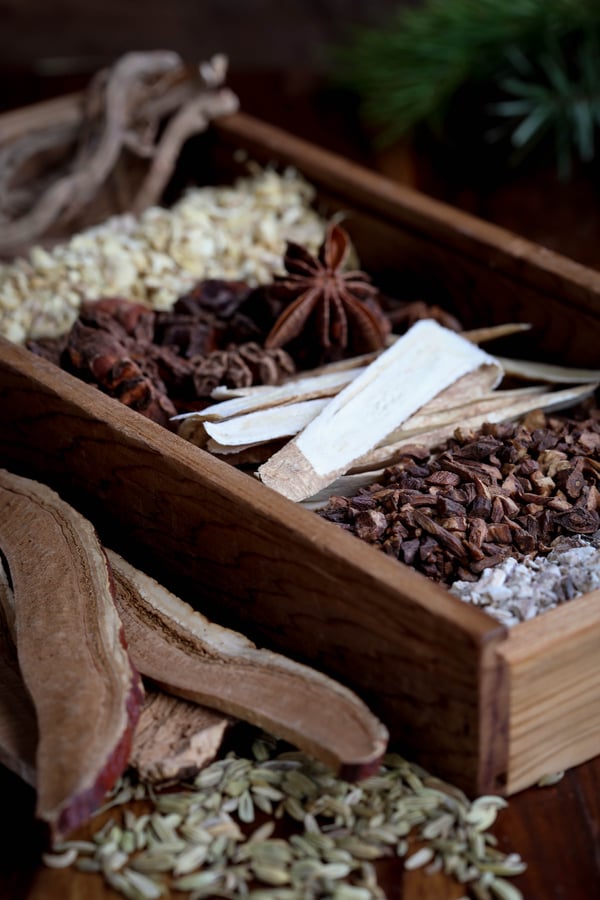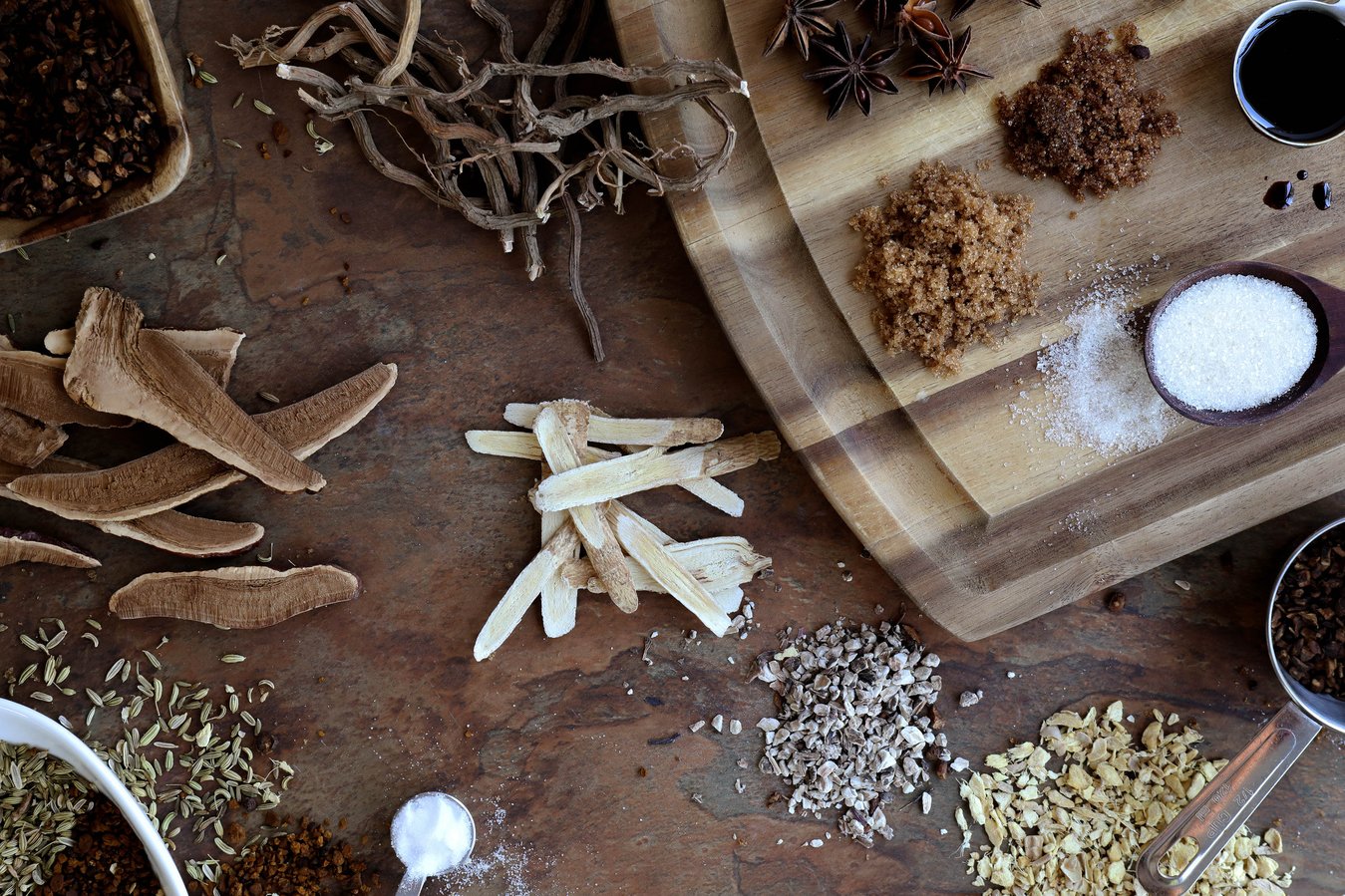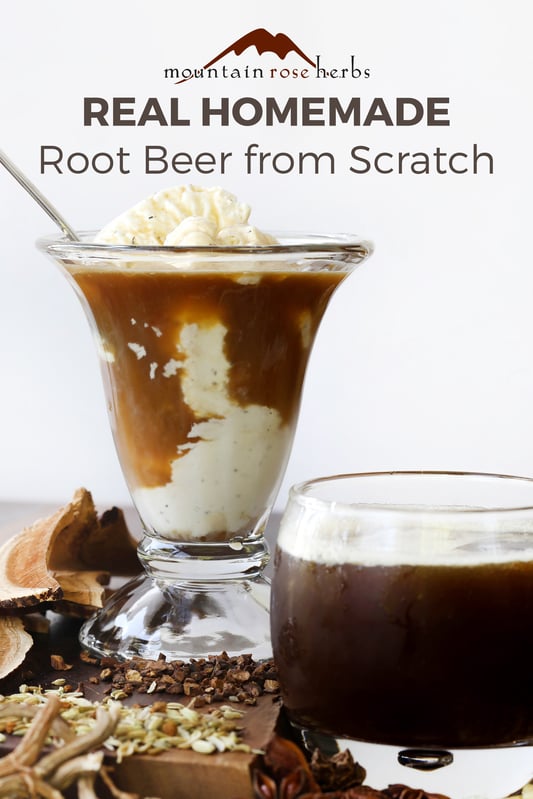Who doesn’t love a frosty, foamy root beer on a hot day? From drive in burger joints to movie theaters, root beer is the classic American drink. However, the corporate world has turned root beer into a cheap artificial drink full of high fructose corn syrup and other artificial flavors. Real homemade root beer is full of healthful and flavorful herbs.
I began making my own herbal root beer when I started teaching herbal mixology classes over ten years ago. My root beer is made with sassafras and birch, a far cry from the root beer found in soda fountains and cans. In this article, I am going to teach you how to formulate your own root beer with a unique and adaptable recipe. Let’s bring back real root beer!
Most commercial root beer doesn’t actually contain any roots. The main ingredient is usually fructose corn syrup which as we all know, can lead to a host of health complications. Other typical less-than-natural ingredients include caramel color and artificial root beer flavor. Making your own root beer lowers the amount of added sugar, while also adding roots that support the immune system. Making root beer is a great family activity everyone can enjoy.
What is Root Beer?
A pharmacist by the name of Charles Elmer Hires developed a formula for root beer in the 1870’s, made from sassafras root bark. The idea came from the mountain folk of Appalachia who had made homemade root tea and other beverages for decades. Hires, who was a temperance movement advocate, originally wanted to call his new beverage "root tea.” Hires’ root “beer” debuted at the Philadelphia Centennial Exposition in 1876 and Hires went on to become the first person to successfully market commercial root beer.
The immune-supporting root beer syrup below is a concentrate made in a crockpot using dandelion, burdock, and ginger, along with other healthful herbs and mushrooms like astragalus, reishi, and chaga. It’s a variation of the classic English burdock beer which has fennel and anise. The secret to good root beer is lots of roots! Each two oz. serving of this syrup has about seven and a half grams of herbs! This would be more than one ounce of a standard 1:5 strength tincture in each two ounces of syrup, and about fifteen capsules of herbs.
Four Square Root Beer Method
Making root beer is a two-day process. On the first day, a decoction (a tea of roots) is made. On the second day the decoction is combined with the other ingredients, including citric acid and sugar. For simplicity, I like to make the root beer as a syrup. A syrup is a concentration of herb decoction and sugar that stores well and can easily be mixed with plain bubbly water to make instant root beer. This avoids buying and using specialized, complicated, and expensive CO2 carbonation equipment. Root beer is made up of four variables: carbonation, root and herb decoction, acid, and sugar.
The first step is a root decoction. Gather the roots and barks for a six-hour long decoction. This extracts the flavor and complexity of the roots. I like using a four-liter crockpot. Add the herbs and water together and set for eight hours and forget about it. The root decoction is divided into three parts. First the base root herbs, then the flavor and spice herbs and finally the foaming and color adjunctive herbs. There are many herbs in each category, it is important to add herbs from each group to the root beer to give it an authentic taste and appearance.
Part One: The Base Herbs
Base Roots and Herbs: The key element are tonic roots and barks that provide a rich mineral taste with astringent (tannin rich) action and dark color. I like using dandelion and burdock which can be roasted to give color and rich taste because of the natural starches. You can use dried herbs and roast them yourself or dig up fresh roots too. The options are almost unlimited but here are common choices:
- Arctium lappa—organic burdock (root)
- Taraxacum officinale—organic dandelion (root)
- Inonotus obliquus—organic chaga mushroom
- Astragalus spp.—organic astragalus root
- Ganoderma lucidum—organic reishi mushroom
- Mahonia spp.—organic Oregon grape root
- Rumex spp.—organic yellow dock
- Chimaphila umbellata—wild-harvested pipsissewa
- Panax spp—organic ginseng root
- Withanina somnifera—organic ashwagandha root
- Aralia racemosa–wild-harvested spikenard
Flavor Spice herbs: These herbs can be roots, seeds, barks, or even leaves, but they must provide flavor. Sassafras is the classic root beer herb, but ginger is also a good choice. Spice herbs that contain higher levels of essential oils, such as cinnamon, cloves, cardamom and anise seed are great options. Spice herbs should be added towards the end of the decoction process. These are well known spice herbs.
-
- Betula lenta—sweet birch
- Betula nigra—black birch
- Sassafras albidum - wild-harvested sassafras
- Pimenta dioica—organic allspice
- Gaultheria spp.—wintergreen leaf
- Theobroma cacao — organic roasted cacao nibs
- Abies balsamea—balsam fir
- Myristica fragrans—organic nutmeg
- Cinnamomum verum—organic sweet cinnamon bark
- Cinnamomum aromaticum – organic cassia cinnamon bark
- Syzygium aromaticum—organic cloves
- Foeniculum vulgare—organic fennel seed
- Zingiber officinale—organic ginger root
- Illicium verum—organic star anise pods
- Pimpinella anisum—organic anise
- Humulus lupulus—organic hop flowers
- Mentha species—organic spearmint leaf
Adjunctive: Foaming and Coloring Herbs
These herbs are important to give the root beer a creamy foam or head. All commercial root beer uses chemical foaming agents, but I like to use herbs that contain natural saponins. The color is also important, and tan to dark brown color is ideal. Roasting the roots to a coffee roast color is helpful for optimal coloring.
Foaming herbs
- Quillaja saponaria—soapbark
- Yucca glauca, wild-harvested yucca root
- Smilax ornata—Jamaican sarsaparilla
- Glycyrrhiza glabra—organic licorice root
Coloring herbs
- Roasted Taraxacum—organic dandelion roots
- Roasted Arctium,—organic burdock root
- Inonotus obliquus—organic chaga (not bitter)
- Glycyrrhiza spp.—organic licorice root (very sweet)
- Salix spp.—organic willow bark (very bitter)
- Cynara scolymus leaf,—organic artichoke (very bitter)
- Roasted Malt—barley
- Molasses (sugar, not an herb)
Part 2: The Sweeteners
Root beer is a sweet drink, although typically not as high in sugar as other cola drinks. The fun part about making your own root beer is that you can adjust the level of sweetener according to your preferences. It is, however, difficult to make root beer with no sugar. One thing that I've learned while drinking and making root beer is that the selection of sugars is as important as the roots. The sugar is a flavor enhancer and it will bring the taste of the root beer out in different ways. Sugar runs the flavor spectrum from light, pure white cane sugar to darker brown sugar, as well as honey and molasses. I have found it is interesting to layer the sugar, meaning to have two to four types of sugar in root beer. This gives a different mouth feel and taste to the final product. Using honey and more natural sweeteners is okay, but I have found that honey has a strong taste, and the smell is often distracting to the flavor. Also note that stevia and artificial sweeteners cannot preserve the final product. I like placing a little of each of the following groups of sugars in the root beer to achieve that nice layering effect.
Light Sweeteners
- Cane sugar
- Beet sugar
- Powdered sugar
- Corn sugar/syrup
- Agave syrup
- Rice syrup
Medium Sugars
- Light to medium brown sugar
- Sucanat
- Turbinado sugar
- Muscovado sugar
- Honey
Dark Sugars
- Molasses
- Licorice extract
- Malt or malt extract (dark)
- Homemade caramel (not commercial)
- Maple syrup
Part 3: The Acids
Most commercial sodas and colas have a very low pH, meaning they are more acidic. We add acid to make the drink crisp and refreshing, and to counter the sweetness. Most of our herbal ingredients are lacking acid so there is a need to add some. Natural citrus juice is a good choice, as well as semi-natural citric acid or malic acid in the purified crystal form. Ideally, you'd want to use pH paper to test the levels of the final product. Generally, a pH of around 3-4 is good; this also helps to preserve the final syrup. Remember that the syrup will also be diluted, and this will lower the acid levels as well.
Natural acids
- Lemon, lime, orange, grapefruit juice
- Cranberry juice
- Vinegar (ascetic acid)
Semi natural acids (from beer brewing stores)
- Non-GMO verified citric acid
- Malic acid
- Tartaric acid
- Ascorbic acid (Vitamin C)
- Phosphoric acid
Part 4: The Carbonation
This is the fun part: bubbles! The bubbles make your drink literally pop. The discovery and use of carbon dioxide made the soda industry. The easiest way to add this element is to mix the root beer base with bubbly water, soda water or sparkling water. It is easy to use a soda stream and make CO2 water very cheaply. The advanced brewer can buy Cornelius kegs and CO2 tanks but that is next level brewing. Mix 1-part syrup to 4 -5 parts bubbly water, stir and you have a fantastic root beer!
Immune Root Beer Syrup: Crockpot Recipe
Makes 134 oz. root beer concentrated syrup, enough for about 67 servings.
Ingredients
- 4 liters cold water.
- 6 oz. dried organic burdock root
- 6 oz. dried organic dandelion root
- 2 oz. dried organic reishi mushroom slices
- 2 oz. dried organic astragalus root slices
- 2 oz. dried organic chaga mushrooms
- 2 oz. Jamaican sarsaparilla root
- 1 oz. dried organic ginger root
- 1 oz dried organic fennel seed
- 1 oz organic star anise pods, crushed.
- 2 organic lemons, zest and juice
- 5 tsp Non-GMO Project Verified citric acid (or any acid)
- 3000 mg of ascorbic acid (Vitamin C)
- 4 oz. molasses
- 8 oz. dark brown sugar
- 12 1/2 oz. organic light brown sugar
- 58 oz. organic cane sugar
Directions
- Preheat oven to 350°F.
- Place the dandelion and burdock roots on cookie sheets. Place cookie sheets in preheated oven for 20 minutes, stirring every five minutes until desired roast, the roots should have the color of light roast coffee.
- Fill crockpot with four liters of filtered water, add roasted dandelion and burdock, reishi mushrooms, astragalus, chaga mushrooms, sarsaparilla root, and ginger root. Set on high for six hours, at least 190°F, Stir every few hours.
- After six hours, turn the crock pot to low, add the fennel, star anise, lemon juice and zest, and simmer another 10 hours or overnight. In the morning it is ready to strain.
- Pour the decoction into a vessel to store in refrigerator for a few hours so sediment can settle to bottom. This is easier to see if you use a glass jar or bowl.
- When sediment is settled, carefully pour out the concentrated tea, leaving sediment behind. Measure yield. You should have about 83 ounces (approximately 10 cups).
- You are going to add an equal amount of the sugar blend you choose—measure out sugars to make a 1-to-1 root beer syrup and set aside.
- Pour tea concentrate into a pot and warm to below boiling or around 180°F.
- Stir in citric acid and ascorbic acid (Vitamin C)
- Slowly add sugar blend. Stir constantly until sugars and citric acid are dissolved.
- Pour into sanitized glass jars to cool.
- When syrup is cool seal with lids and store in refrigerator.
- Syrup will keep in refrigerator for up to three months.
- To use, mix 2 oz. concentrate to six or eight oz. of bubbly water, stir to mix.
- You can also add ice or even vanilla ice cream. Enjoy!
Looking to work more herbs into your daily routine?
Find other healthful beverage ideas!
You might also like:
DIY Tea and Herb-Infused Syrups
How to Make Mead with Herbs and Spices
DIY Spiced Coconut Creamer


















